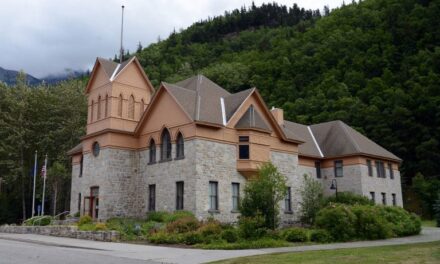
Earthquakes and aftershocks registered between the U.S./B.C. border and the Yukon on Monday, May 1. (University of Alaska Fairbanks Alaska Earthquake Center)
May kicked off to a shaky start in Northern Southeast Alaska. Two major earthquakes woke residents early Monday morning. They were some of the most powerful quakes Haines area residents have felt in years, but caused hardly any damage in Alaska.
The first quake struck around 4:30 a.m. According to the University of Alaska Fairbanks’ Alaska Earthquake Center, it had a magnitude of 6.2.
The quake was centered in a remote area between the U.S./British Columbia border and the Yukon. It was about 55 miles from Skagway and 60 miles from Haines.
Jim Stanford lives about 26 miles up the Haines Highway.
“We were shaken violently out of bed, “says Stanford. “Our house shook real good. Probably in over 30 years that’s the most violent shake we’ve felt.”
Stanford says the quake knocked pictures off the walls and glasses off shelves, but there wasn’t any structural damage to his home.
Adrian Revenaugh lives about a mile from the border.
“We’ve lived with earthquakes forever,” says Revenaugh. “Thirty-five years’ worth. This was probably the most dramatic in regards to actually being able to feel it.”
A little after 6 a.m., Revenaugh felt the second quake, which was a little bigger than the first at an about 6.3 magnitude quake.
“I mean you could just really feel the whole ground,” says Revenaugh. “You could feel simultaneous movement in different areas of the house.”
According to the Earthquake Center, that one occurred in the same area as the first. The organization’s state seismologist Michael West says while the quakes caught area residents off guard, they are not surprising. He says they occurred around the Denali Fault System, one of the most prominent in the state.
Alaska is earthquake country, the most seismically active region in the U.S.
No significant damage has been reported in Haines or Skagway. The same goes for Juneau.
But that wasn’t the case in Whitehorse, the Yukon’s largest city. According to the CBC, the city experienced power outages and buildings were damaged. CBC radio host Sandi Coleman was interviewing a seismologist live on the air when the second earthquake struck.
More than 100 aftershocks were reported throughout the day Monday. Seismologist West says those are expected to continue in the days, maybe even weeks to come. But, he says the intensity will taper off.
West says the quakes occurred close to the earth’s surface.
“So these earthquakes were essentially right along the Haines Highway corridor,” says West. “They were very shallow in the earth which makes the shaking much stronger.”
West says it is fortunate they occurred in a remote spot. The location in the unpopulated area off the Haines Highway helped limit the damage caused by the quakes.
“These are the same size earthquakes that killed 250 people in Italy last summer. Killed 150 people in New Zealand just a couple of years ago. So these are very, very vigorous earthquakes,” says West. “We’re fortunate that Whitehorse, Haines, some of our other nearby communities were actually at some distance from this earthquake.”
According to responses on the U.S. Geological Survey’s website, residents as far south as Petersburg reported feeling the earthquakes.
In the event of a quake, experts recommend getting on the ground, finding cover from falling objects, and holding on. They use the catchphrase ‘drop, cover and hold.’
The Alaska Tsunami Warning Center said there was no tsunami risk from the earthquakes.
The Haines and Klondike Highways remained open Monday, with no damage to the roads reported.









Destroyed my computer in my office when books fell on it.